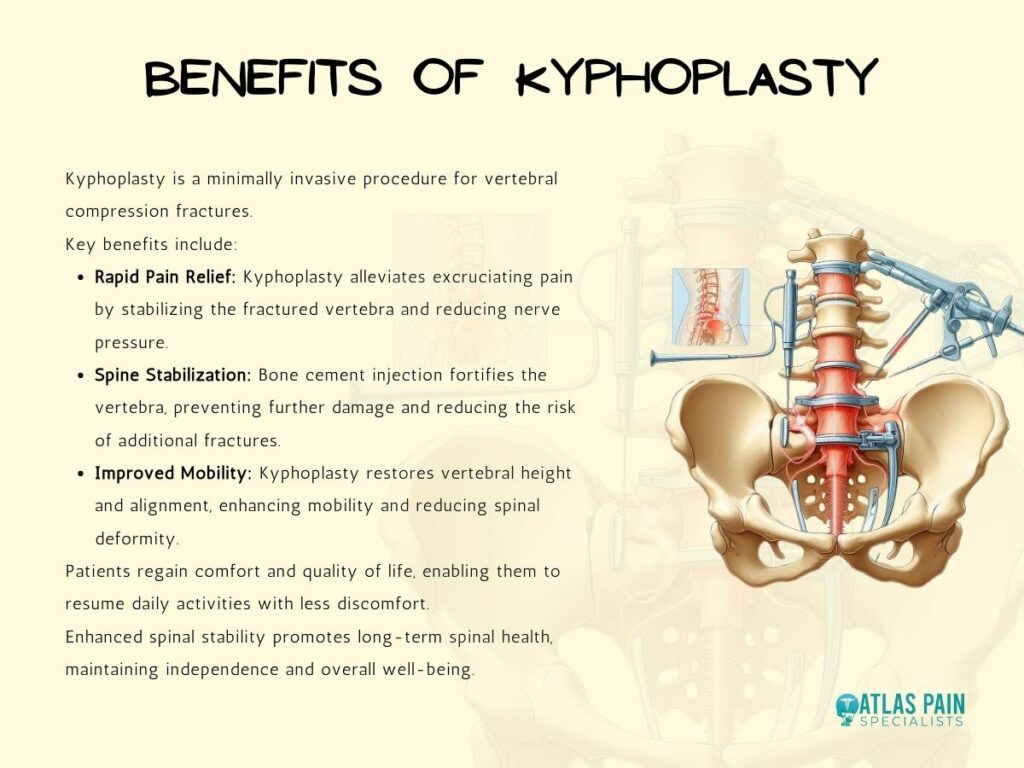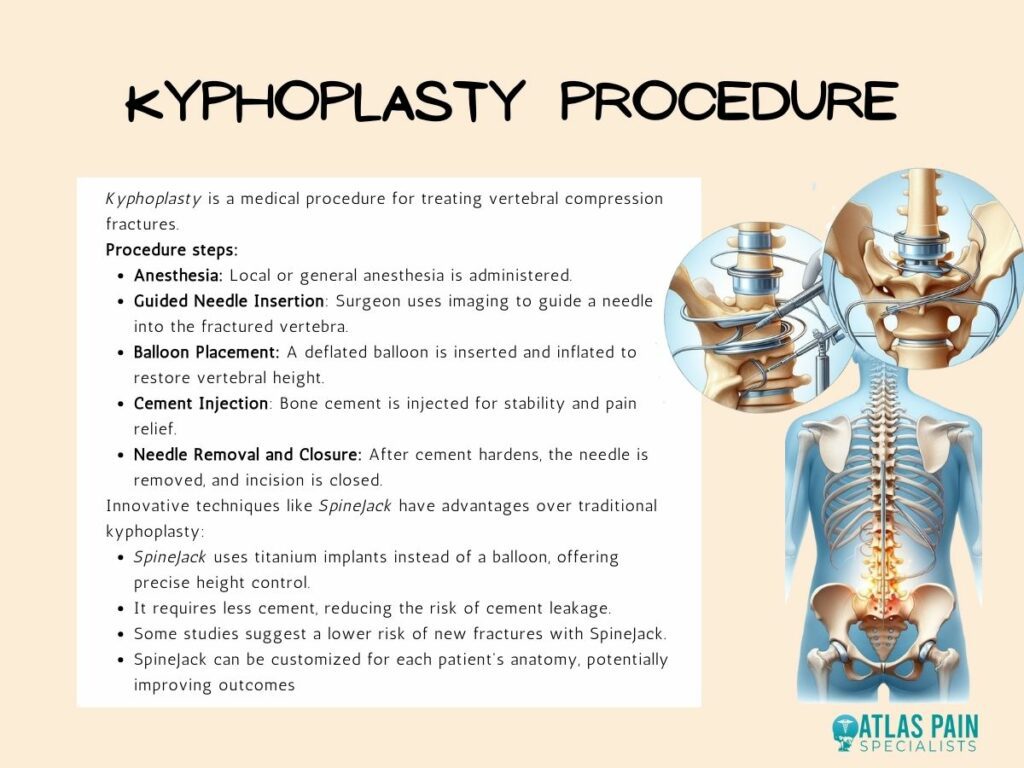

Kyphoplasty for Spinal Compression Fractures: What to Expect
Spinal compression fractures, often associated with osteoporosis, are a significant concern for the elderly population, causing considerable pain and mobility issues. "Kyphoplasty for Spinal Compression Fractures" is a minimally invasive procedure that has emerged as a promising treatment option for patients suffering vertebral compression fractures. This blog post will discuss the basics of kyphoplasty, its benefits, and what to expect before, during, and after the procedure.
Table of Contents
What is Kyphoplasty?
Kyphoplasty is a surgical technique that involves the following steps:
- A needle is introduced into the fractured vertebral body.
- A small tube is inserted over the needle, which allows the surgeons to access the fractured area.
- Bone cement is injected into the fractured vertebra, filling the void and stabilizing the spine.
Benefits of Kyphoplasty
Kyphoplasty is a minimally invasive procedure that offers several key benefits to individuals suffering from vertebral compression fractures:

- Pain Relief: One of the primary advantages of kyphoplasty is its ability to provide rapid pain relief. By stabilizing the fractured vertebra and reducing pressure on nerves, the procedure alleviates the excruciating pain associated with compression fractures. Patients can regain their comfort and quality of life, allowing them to resume daily activities with reduced discomfort.
- Stabilization of the Spine: Kyphoplasty effectively stabilizes the spine. The procedure involves the injection of bone cement into the fractured vertebra, fortifying it and preventing further damage. This stabilization not only aids in pain relief but also reduces the risk of additional fractures, promoting long-term spinal health.
- Improved Mobility: After kyphoplasty, patients often experience improved mobility and reduced spinal deformity. By restoring vertebral height and alignment, the procedure enables individuals to lead a more active and fulfilling life. Regaining mobility is crucial for maintaining independence and overall well-being.
Preparing for Kyphoplasty
Kyphoplasty is a minimally invasive surgical procedure used to treat vertebral compression fractures, often caused by conditions like osteoporosis or trauma. Before undergoing kyphoplasty, several critical considerations and evaluations are necessary to ensure the procedure's success and minimize potential risks and complications.
Pre-procedural Considerations and Evaluations
Before the kyphoplasty procedure, thorough evaluations and discussions with your healthcare team are crucial. These steps help determine the appropriateness of the procedure for your specific case and include:
- Medical History: Your medical history, including any underlying health conditions, medications, allergies, and previous surgeries, will be reviewed. This information is essential to assess your overall health and plan for a safe procedure.
- Imaging Studies: X-rays, CT scans, or MRI scans will be conducted to locate the vertebral fracture precisely, assess its severity, and evaluate the surrounding structures. This information guides the surgeon during the procedure.
- Pain Management Discussion: If you're experiencing severe pain, especially in conditions like Complex Regional Pain Syndrome (CRPS), alternative pain management options will be discussed.
- Blood Tests: Blood tests are often performed to check your clotting factors, blood cell counts, and overall health. This helps ensure that you're a suitable candidate for surgery.
Potential Risks and Complications
While kyphoplasty is considered a safe procedure, it is essential to be aware of potential risks and complications:
- Infection: Although rare, there is a risk of infection at the incision site or in the treated vertebra. Strict sterile techniques are employed to minimize this risk.
- Nerve Injury: There is a small chance of injuring nearby nerves during the procedure, which can cause neurological symptoms. However, this risk is minimized with the use of imaging guidance.
- Cement Leakage: The injected bone cement used to stabilize the fracture can potentially leak into surrounding tissues. This may cause irritation or compression of nearby structures, although modern techniques aim to minimize this risk.
- Allergic Reactions: While rare, some individuals may experience allergic reactions to the materials used during kyphoplasty. A thorough evaluation of your medical history helps identify potential allergies.
- Persistent Pain: In some cases, patients may continue to experience pain despite the procedure's success. This can occur due to underlying conditions or other factors.
The Kyphoplasty Procedure
Delving into the realm of medical procedures, the kyphoplasty stands out as a notable intervention for addressing vertebral compression fractures. This concise guide provides a step-by-step elucidation of the kyphoplasty procedure, shedding light on the intricacies involved in this spinal treatment.

Step-by-step Explanation of Kyphoplasty
The kyphoplasty procedure typically follows these steps:
- Anesthesia: You will be given local or general anesthesia to ensure you're comfortable during the procedure. Your healthcare team will discuss the best option for you based on your health and preferences.
- Guided Needle Insertion: Using fluoroscopy or other imaging techniques, the surgeon guides a needle into the fractured vertebra.
- Balloon Placement: A deflated balloon is inserted through the needle and then inflated within the fractured vertebra. This creates a cavity and restores the vertebral height.
- Cement Injection: Once the cavity is created, bone cement is injected into the space to stabilize the vertebra and provide pain relief.
- Needle Removal and Closure: After the cement hardens, the needle is removed, and the incision site is closed with sutures or adhesive.
Comparison of Traditional Kyphoplasty and Innovative Techniques
In recent years, innovative techniques like the SpineJack have emerged as alternatives to traditional kyphoplasty. These techniques offer some distinct advantages:
- SpineJack: The SpineJack procedure involves the insertion of titanium implants into the fractured vertebra rather than inflating a balloon. This technique allows for more precise control over vertebral height restoration.
- Less Cement Usage: SpineJack typically requires less bone cement, which can reduce the risk of cement leakage and potential complications.
- Minimized Fracture Risk: Some studies suggest that SpineJack may have a lower risk of new fractures compared to traditional kyphoplasty.
- Individualized Approach: SpineJack can be tailored to each patient's specific anatomy, potentially improving outcomes.
Recovery and Rehabilitation After Kyphoplasty
Kyphoplasty is a promising procedure for treating vertebral compression fractures, particularly beneficial for individuals dealing with conditions like Complex Regional Pain Syndrome (CRPS). After the procedure, a well-structured recovery and rehabilitation plan are essential for optimal outcomes.

Expected Recovery Timeline and Post-Procedural Care
- Immediate Post-Procedure: After kyphoplasty, you'll be monitored in a recovery area. Most patients can return home the same day, but it's crucial to have someone available to drive you.
- Pain Management: While kyphoplasty aims to alleviate pain, some discomfort may persist for a few days. Your healthcare team will prescribe pain medications to manage this.
- Activity Level: Initially, you may be advised to limit strenuous activities. Light walking is encouraged to prevent blood clots and promote circulation.
- Incision Care: Keep the incision site clean and dry. Follow your surgeon's instructions for wound care to prevent infection.
- Follow-up Appointments: Regular follow-up appointments with your healthcare provider are essential to monitor your progress and make any necessary adjustments to your treatment plan.
Rehabilitation Exercises and Activities to Promote Spinal Health
Rehabilitation plays a vital role in recovering after kyphoplasty and maintaining spinal health:
- Physical Therapy: A physical therapist can create a customized exercise program to improve flexibility, strengthen core muscles, and enhance posture.
- Range of Motion Exercises: Gentle stretches and range of motion exercises can prevent stiffness and improve mobility.
- Weight-Bearing Activities: Engage in weight-bearing exercises like walking and light resistance training to maintain bone density.
- Balanced Diet: A diet rich in calcium and vitamin D promotes bone health and can help prevent future fractures.
- Posture Awareness: Practicing good posture reduces strain on the spine and lowers the risk of future fractures.
Long-Term Outcomes and Considerations of Kyphoplasty for Spinal Compression Fractures
Exploring the horizon of medical interventions, the long-term outcomes of kyphoplasty emerge as a beacon of promise in the realm of addressing vertebral compression fractures. This brief overview delves into the sustained effectiveness of kyphoplasty, offering insights into its enduring impact on patients' well-being over an extended period.
Long-Term Effectiveness of Kyphoplasty
The long-term effectiveness of kyphoplasty is promising:
- Pain Relief: Many patients experience immediate pain relief following the procedure. Long-term pain reduction is often sustained, contributing to improved quality of life.
- Vertebral Stability: Kyphoplasty stabilizes fractured vertebrae, reducing the risk of further collapse and fractures.
- Improved Function: Patients often regain the ability to perform daily activities, enhancing their overall functionality.
Lifestyle Modifications and Preventive Measures for Spinal Compression Fractures
To maintain spinal health and prevent future compression fractures, consider the following lifestyle modifications:
- Regular Exercise: Continue with your rehabilitation exercises and engage in regular physical activity to strengthen muscles and bones.
- Dietary Changes: Consume a diet rich in calcium and vitamin D. Discuss supplements with your healthcare provider if necessary.
- Fall Prevention: Minimize fall risks at home by removing hazards and using assistive devices if needed.
- Medication Management: If you have underlying conditions like osteoporosis, adhere to prescribed medications to improve bone density.
- Healthy Lifestyle: Avoid smoking and limit alcohol consumption, as these habits can weaken bones.
Stretches For Spinal Decompression
We have discussed the importance of Kyphoplasty as a valuable medical procedure for addressing spinal compression fractures. This minimally invasive technique offers relief from pain and helps in restore spinal stability and function.
However, maintaining spinal health doesn't end with medical interventions alone. To complement these treatments and prevent future issues, incorporating regular stretches for spinal decompression into your daily routine is essential.
Now, let's shift our focus to a series of effective stretches that can promote spinal decompression, relieve tension, and support your overall spine health. These stretches are not only simple to perform but can also be a valuable addition to your wellness regimen, ensuring a strong and pain-free back. So, let's explore these stretches and take a proactive step towards a healthier spine.
About Dr. Sean Ormond



